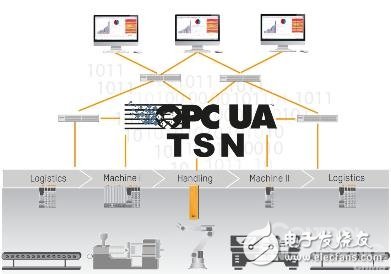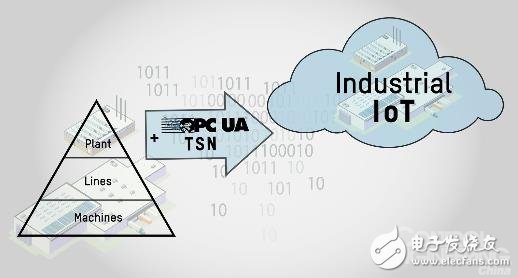The position of the industrial Internet of Things in the future development of the manufacturing industry has become an undisputed consensus of the industry. A lot of investment is going on in this huge potential area, however, so far many have remained on the surface. Stimulated by the needs of end-users, automation vendors understand the first paradox of IIoT encountered: seamless integration based on open standards. The convergence of time-sensitive networks (TSNs) and OPC UA provides high-precision access to machines, controllers, and I/O—without having to consider who the underlying device is.

OPC UA TSN meets all the communication needs required for today's manufacturing applications
As an open protocol, OPC UA has been widely used in the industrial field. Almost all manufacturers offer support for OPC UA in their controllers or other products. The corresponding technologies are developed and promoted by different members under the unified coordination and management of the OPC Foundation. Machines and equipment operators are no longer concerned about the potential risks of being tied to the manufacturer by simply worrying about the choice of communication technology.
Through standardized system connections, they can share the same access technologies and focus on solving new challenges. In the past, we have become accustomed to 30 to 40 nodes in the network, and in the future we can even see that 1000 or more nodes appear in the application.
Continuously growing node
The challenge is to find the number of nodes that manage how to manage and grow sustainably. For this challenge, automation vendors also need to differentiate their customers to provide value-added opportunities. As a result, software for the setup and configuration of a large number of nodes in a complex network of pipelines has become increasingly important, and these tools can be designed to be applied without the need for complex IT training.
In addition to the rapid growth in the number of nodes, and the amount of data will increase exponentially, it is very difficult for traditional industrial bus protocols to cope with such a large amount of data flooding, which is the direction that OPC UA is committed to substantial improvement.
Information, not data
The biggest advantage of OPC UA is the information model (the traditional bus system transmits unstructured data - there is no information such as unit, data affiliation, read and write attributes, etc.), and applications running on the controller know how to parse these methods using well-known methods. Data, how to use the object dictionary query method.
This method obviously has no problem when the machine is running independently. However, as the machine data is applied by other machines, SCADA systems and even cloud-based ERP systems, these data transmissions will lack semantic information, but only unstructured. Numbers.
Fewer errors
In the past, semantic contexts were transmitted through long forms or even handwritten forms. This tedious work, and often the source of errors, was gradually replaced by OPC UA, making it possible to implement convenient and efficient agile manufacturing solutions. .
Through its information model, OPC UA can not only transmit data, but the transmitted information can be correctly parsed by any node on the network without further explanation. For example, we have a sensor that measures a temperature of 5 degrees Celsius. According to the conventional discussion, the controller will receive it as an integer data type with a value of "5", ie, it is only represented as a value on the controller. Without semantics, the controller's application only applies it to a limited number.
OPC UA uses a different method. The value "5" is provided along with its semantic content. Celsius, upper and lower limits, and events are also provided.
Message requirement
Since the nodes on the OPC UA network can also query this information, this makes it possible to use it in a wider range of ways. If you want to generate an ERP report, the ERP system can browse the network to get relevant information. Once found, this information can be collected into a database and viewed in the report. In the past, these data need to be transmitted manually, and the semantic information of each individual value needs to be stored in the ERP system. With such a static structure, changes in the variables on the machine also require reprogramming in the ERP system.
This example highlights the fact that OPC UA simplifies communication from the control layer to higher level systems. However, we have encountered new obstacles when more advanced IT systems send queries to the machine network (here we become operational technology or OT) The network load is inevitably increased.
For IT networks, millisecond delays are acceptable, but for high precision manufacturing processes, microseconds are necessary. In this case, a millisecond delay may cause the machine to shut down, reducing product quality and even causing personal injury to the device. This is why almost every manufacturer has additional IT and OT systems for independent operation and maintenance. The IT network lacks deterministic and periodic data message transmission capabilities - and this is necessary at the OT level.
a shared network
The IT network follows the well-known "best effort transmission" principle - which means that packet priority and transmission are as fast as possible. If the capacity exceeds the load on any node, it will cause a bottleneck - however this is not allowed in the machine network. Until now, some basic network facilities have not been able to achieve maximum effort and periodic data transmission. With the advent of TSN, this problem can be solved. TSN is an extension of the Ethernet standard and will be used to solve the transmission of general data and time-critical data in the same network.
The first step is timing and reduced latency for deterministic data transmission of the device network, and the IEEE 802.1AS-Rev standard was developed to achieve this goal. It describes the mechanism by which all nodes in the network establish a unified network clock synchronization.
The next step is to protect the priority of deterministic data, which is done by IEEE802.1 Qbv and Qba—they define that the network interaction must be run in a time frame that is guaranteed to determine the data, which means that other messages must wait.
In order to establish a unified network configuration, the Traffic Reservation Protocol (IEEE802.1Qcc) provides a standard interface and mechanism for configuration. NETCOF above TLS as a configuration protocol.
Goodbye - bandwidth problem
If it is possible to combine two transmission mechanisms in one network, this allows periodic data transmission and non-time-critical data to be transmitted at the same physical layer, since modern production lines are increasingly dependent on Gigabit networks or even higher. This makes network bandwidth bottlenecks including traditional fieldbus, as well as 100M Ethernet, can be solved simultaneously.
The convergence of OPC UA and TSN will be the new industrial automation architecture to the stage. The most noteworthy feature of this new design is that it eliminates the boundaries between IT and OT networks. This not only allows the new plant to be fully connected, but also allows the old plant to be connected as well. With B&R's Orange Box, a large number of devices can be integrated into the production network via OPC UA, which is not required for existing machines. Any change.
B&R is actively involved in the integration of OPC UA and TSN from experimental exploration to testing and product development. B&R saw the great potential of OPC UA TSN for the operation of machines and equipment, so it spared no effort to promote the development of this technology in practical applications.
The prototype of B&R's OPC UA TSN has been tested for interoperability with other IT and OT manufacturers in the test bed – this is done under the IIC. So far, very good application results have been achieved. In addition, OPC UA is very fast able to provide a transport layer for high real-time and low jitter.

OPC UA TSN will provide a seamless vertical manufacturing connection solution

Landscape brightening,Landscape lighting,Led landscape lighting
Kindwin Technology (H.K.) Limited , https://www.ktlleds.com